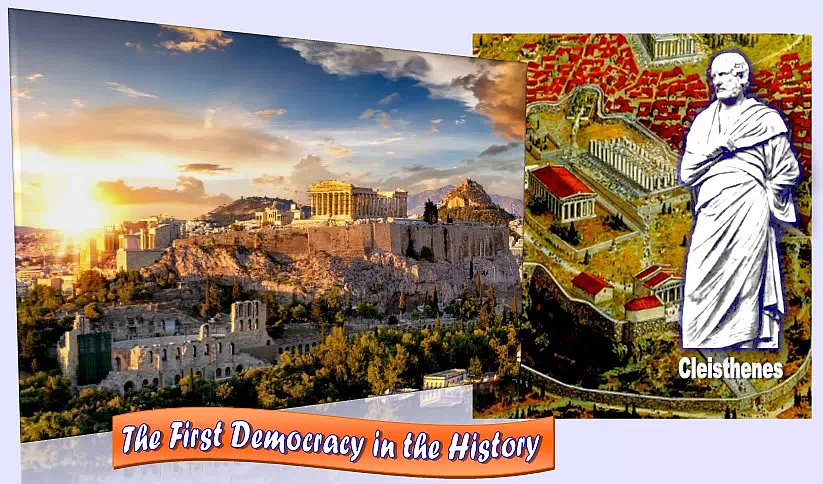The First Democracy in the History….
It was the time around 500 BCE… And…
The foundation years of the First Ever Known Democracy in the World.
Athens, the capital of Greece, was filled with the conflicts and fights between people and factions of nobles.
Cleisthenes, the creator of the first democratic structure in the world, was busy spending his time for the social rights against feudalistic society deeply rooted in Greece those days. His reforms consolidated democratic process begun by Solon and influenced the policies of Pericles.
Cleisthenes (Clisthenes) lived between c 570 and c 508 BCE. He was statesman and the principal archon of Athens during 525and 524 BCE.
Archon was one of the nine chief magistrates in ancient Athens.
Who was Solon?
Solon (c. 630 – c. 560 BCE):
Solon was the Athenian statesman, poet, economist and lawgiver. He was one of the seven sages. His legal, constitutional and economic reforms made the existing code of laws established by Draco less severe. He proposed to divide citizens into four classes based on wealth (rather than birth). He was considered to have laid the foundations of Athenian democracy.

Who were the seven sages?
In ancient Greek mythology, Thales, Pittacos, Solon, Cleovoulos, Periandros, and Chilon were considered as the seven sages. They are said to have lived around in ancient Greek over 600 years BCE. They laid the foundation for the ancient Greek philosophy. After them the neoclassical era of Greek philosophy started with Socrates, Plato, Aristotle, etc.
Who was Draco?
He lived in 7th century BCE. He was Athenian legislator (lawmaker). His codification of Athenian law was notorious for its severity. He prescribed death penalty for almost every offence even for trivial ones.
Who was Pericles?
Pericles lived between c. 495 and 429 BCE. He was the Athenian statesman and general. He was considered as the champion of Athenian democracy. He pursued an imperialistic policy. He played a crucial role in the Peloponnesian War by masterminding Athenian strategy. He promoted a flourishing culture of Athens by commissioning the building of the Parthenon in 447 BCE.

Peloponnesian War:
It was the war between Athens and Sparta with their respective allies from 431 to 404 BCE.
Sparta was a famous ancient Greek city in the southern Peloponnese in Greece. It was a powerful city state in the 5th century BCE.
Parthenon:
It was the main temple of the goddess Athena Parthenos (Pallas, Roman equivalent Minerva), meaning ‘maiden’. She was goddess of wisdom and useful arts and prudent warfare. She was considered to be the guardian of Athens.
Pericles built Parthenon on the Acropolis in 447-432 BCE. It was constructed to honor the Athens’ patron goddess and to commemorate the victory of Greece over the Persians. Greek architects Ictinus and Callicrates with the help of sculptor Phidias designed this temple.
The height of the statue was said to be about 12 m (38 feet). More than a ton of gold was used to build the statue. The statue is said to have remained for more than a millennium (1000 years). A new statue of Athena in the same form was erected in 1990 in Nashville, Tennessee.
Acropolis:
It was the ancient citadel at Athens. It is the site of the Parthenon and other notable buildings, mostly dating from the 5th century BCE.
How the First Democracy in the World Formed:
Cleisthenes’s fight against other Athenian noble factions continued for several years in exile and put a foundation for the influential democracy for the first time in history.
With the support of common people, finally, he got the power. Then onwards he tried to reform the laws laid by Solon. His best attempts to balance the interest of the different communities of Athens gave fruitful results.
Family/Clan System Banned:
Cleisthenes is thought to ban the political system prevailed in Greece based on family and clan. Instead, he set up a legislative council called ‘boule’, with ten tribes organized from villages or demes.

The legislative council was formed from 500 representatives. The representatives were elected by citizens with quotas among demes or villages.
The Cleisthenes democracy, in later years, took the shape of three branches.
1. Ekklesia: The Assembly.
2. Boule: The Council of 500 Representatives.
3. Dikasteria: The Courts.
Election Process & Eligibility:
Eligibility to contest as the representative candidate was very strict. He formed severe rules for the duration of the representative in council as well. This strictness was similarly applied to departments of courts and army system.
Cleisthenes established such administrative system that widened the ways for public participation and reduced the dominance of cliques (group-politics).

Ending of Tyranny:
Cleisthenes ended tyrannical rule by implementing the new legislative system. He called this democratic system “Isonomia” (equal rights for all). Many historians regards this system as the beginning of democracy though slightly deferred from today’s meaning of democracy as – “rule by the people”.
He mitigated the ill effects by politics by noble groups thus ended the tyranny in Greece.
The Golden Age of Athens:
Though he favored for equal rights for all, he tried to keep the traditional culture of Greeks intact in many ways. The democracy and culture flourished equally by his new system and reforms.

No doubt, here he was successful to establish the direct democracy by making all people participate equally, which is considered as the beginning of the first democracy in the history.
- He is regarded as the father of democracy, and Athens (the capital city of Greece) as the birthplace.


